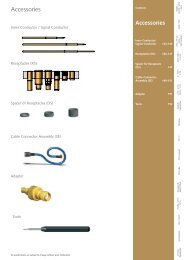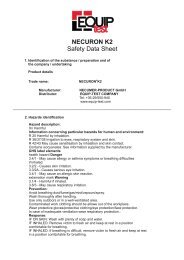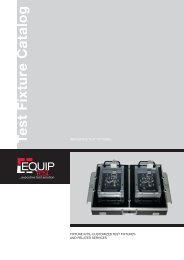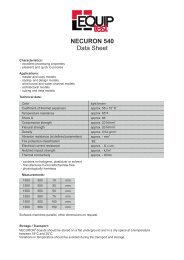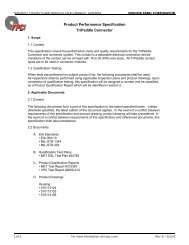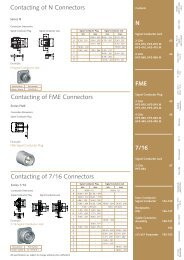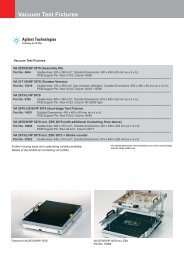You also want an ePaper? Increase the reach of your titles
YUMPU automatically turns print PDFs into web optimized ePapers that Google loves.
MICRO COAXIAL CONTACTS AND MODULES USER’S MANUAL: SECTION 1VIRGINIA PANEL CORPORATIONMICRO COAXIAL RECEIVER CONTACT ASSEMBLY50 OHM • PART # 610 140 101 FOR RG 316, PART # 610 140 102 FOR RG 17875 OHM • PART # 610 140 103 FOR RG 179TOOLS REQUIREDSoldering Fixture, Part # 910 121 178Hex Crimp Tool Kit, Part # 910 101 131 for RG178 • 910 101 132 for RG179/316Contains: Crimper, Locator, Part # 910 101 135, and .050” Allen WrenchInspection Depth Gauge, Part # 910 121 179ASSEMBLY INSTRUCTIONS1. Strip the outer insulation of the wire (Figure A).OUTER INSULATIONDimensions shown: [millimeters]inches[5.1]0.202. Slide the ferrule onto the wire and fold braid back over ferrule(Figure B). Comb braid and make sure that it covers 50-100% ofthe smaller portion of the ferrule but does not reach past theshoulder.3. Strip wire center conductor (Figure C).4. Solder wire center conductor into contact center conductor,and clean (Figure D).NOTE: Contact center conductor and dielectric must touch(Figure E).5. Calibrate the Inspection Depth Gauge, Part # 910 121 179(Figure F), by loosening the dial face retaining screw until thedial face allows itself to be turned. Insert the calibration pluginto base of gauge. While keeping constant pressure on theplug, adjust the dial by rotating it such that the pointer pointsto “0”. Re-tighten retaining screw. Adjust locating markers to“8” and “97”.Figure A. Strip outer insulation to dimension shown.Figure B. Slide ferrule onto wire.Figure C. Strip wire center conductor to dimension shown.FERRULEFERRULEBRAIDBRAIDWIRE CENTERCONDUCTORDIELECTRICNO BRAID PASTSHOULDER[1.5]0.06CONTACTCENTERCONDUCTORContinued on next page...WIREBRAIDSOLDERFIXTUREFigure D. Soldering Fixture, Part # 910 121 178.DIELECTRICNO GAPPERMISSIBLESOLDERFigure E. Ensure contact center conductor anddielectric touch.CONTACTCENTERCONDUCTORFigure F. Inspection Depth Gauge, Part # 910 121 179.1-1 For more information visit vpc.com2/19/10
MICRO COAXIAL CONTACTS AND MODULES USER’S MANUAL: SECTION 1VIRGINIA PANEL CORPORATIONMICRO COAXIAL RECEIVER CONTACT ASSEMBLY50 OHM • PART # 610 140 101 FOR RG 316, PART # 610 140 102 FOR RG 17875 OHM • PART # 610 140 103 FOR RG 179ASSEMBLY INSTRUCTIONS, CONTINUED6. Slide shield conductor over center conductor until the shieldconductor stops flush (Figure G).NOTE: Do not twist the shield conductor; twisting will cause thebraid to bunch.MAINTAIN FLUSHWITH FERRULESHIELDCONDUCTORFigure G. Shield conductor must be flush with ferrule.7. Check the flush +.003″/ -.008″ dimension (Figure H) by using theinspection depth gauge. Insert contact into gauge until contactstops. If pointer measures between “8” and “97”, go to step 8.If the pointer is out of the range of the two markers, slide theferrule to adjust. Repeat steps 1-7 if necessary.8. Before using the Hex Crimp Tool (Figure J), you must install thelocator (Figure K). Remove the 2 screws using the .050” Allenwrench and replace the existing locator with the Locator, Part #910 101 135 (Figure L). Tighten the 2 screws. The tool is now readyto crimp receiver contacts.Figure H. Flush dimensions.[0.07].003[0.20].0089. Crimp using the Hex Crimp Tool in larger opening for RG 316 andRG 179, or smaller opening for RG 178. To ensure proper crimpposition, press shield conductor flush inside the locator (FigureM).OBSERVE PRECISION RATCHET ACTION BY OPENING ANDCLOSING CRIMP TOOL FULLY SEVERAL TIMES. THETOOL CANNOT BE OPENED WITHOUT COMPLETINGA CYCLE. NEVER ATTEMPT TO DISASSEMBLE TOOL.NEVER TIGHTEN OR LOOSEN STOP NUTS ON BACK OFTOOL.Figure J. Hex Crimp Tool Kit, Part #910 101 131 for RG178 • 910 101 132for RG179/316.Figure K. Locator,Part # 910 101135.Wire must not be allowed to pull on the center conductor duringcrimping (for example, long wire hanging down to floor). Ensureouter shield is flush with ferrule after crimping (Figure N).9. Use the inspection depth gauge to verify the flush +.003″/ -.008″dimension as shown in step 7. If the dimension is out of range,repeat steps 1-10.Figure L. Locator in die assembly.LOCATORFigure M. Contact with locator.HEX CRIMP AREAFigure N. Final assembly.MAINTAIN FLUSHWITH FERRULE1-2 For more information visit vpc.com2/19/10
MICRO COAXIAL CONTACTS AND MODULES USER’S MANUAL: SECTION 1VIRGINIA PANEL CORPORATIONMICRO COAXIAL RECEIVER CONTACT ASSEMBLY50 OHM • PART # 610 140 104 FOR RG 316DSDimensions shown: [millimeters]inchesTOOLS REQUIREDSoldering Fixture, Part # 910 121 178Inspection Depth Gauge, Part # 910 121 179ASSEMBLY INSTRUCTIONS1. Strip the outer insulation of the wire (Figure A) and tin thebraid.2. Perform second strip (Figure B). 0.17” will be trimmed from thefront of the wire to remove any solder build up.3. Solder wire center conductor into contact center conductor,and clean (Figure C).NOTE: Contact center conductor and dielectric must touch(Figure D).4. Calibrate the Inspection Depth Gauge, Part # 910 121 179(Figure E), by loosening the dial face retaining screw until thedial face allows itself to be turned. Insert the calibration pluginto base of gauge. While keeping constant pressure on theplug, adjust the dial by rotating it such that the pointer pointsto “0”. Re-tighten retaining screw. Adjust locating markers to“8” and “97”.5. Slide the shield conductor over the center conductor andcheck the flush +.003″/ -.008″ dimension (Figure F) by usingthe inspection depth gauge. Insert contact into gauge untilcontact stops. If the pointer measures between “8” and “97”,go to the next step. If the pointer measures below the “97”marker, slide the shield to adjust. If the dimension measuresabove the “8” marker, cut the strip off and repeat steps 1-5.6. Solder the shield and clean (Figure G).NOTE: Make sure the shield does not move when soldering.OUTER INSULATION[6.35].25BRAID[10.67].42Figure A. Strip outer insulation to dimension shown.WIREBRAIDDIELECTRICSOLDERFIXTURE[2.29].09[1.52].06[4.32].17WIRE CENTERCONDUCTORFigure B. Second strip will remove any solder build-up.Figure C. Soldering Fixture, Part # 910 121 178.NO GAPPERMISSIBLEDIELECTRICCONTACT CENTERCONDUCTORSOLDERFigure D. Ensure contact center conductor anddielectric touch.CONTACT CENTERCONDUCTOR7. Use the inspection depth gauge to verify the flush +.003″/-.008″ dimension as shown in step 5. If the dimension is out ofrange, repeat steps 1-7.Figure E. Inspection Depth Gauge, Part # 910 121 179.[0.07].003Figure F. Flush dimensions.[0.20].008SHIELD CONDUCTORFigure G. Assemble shield conductor.1-3 For more information visit vpc.com2/19/10
MICRO COAXIAL CONTACTS AND MODULES USER’S MANUAL: SECTION 2VIRGINIA PANEL CORPORATIONMICRO COAXIAL ITA CONTACT ASSEMBLY50 OHM • PART # 610 141 101 FOR RG 316, PART # 610 141 102 FOR RG 17875 OHM • PART # 610 141 103 FOR RG 179TOOLS REQUIREDSoldering Fixture, Part # 910 121 178Hex Crimp Tool Kit, Part # 910 101 131 for RG178 • 910 101 132 for RG179/316Contains: Crimper, Locator, Part # 910 101 139, and .050” Allen WrenchInspection Depth Gauge, Part # 910 121 180ASSEMBLY INSTRUCTIONS1. Strip the outer insulation of the wire (Figure A).2. Slide the ferrule onto the wire until it stops on outer insulation andfold braid back over the ferrule (Figure B). Comb braid and makesure that it covers 50-100% of the smaller portion of the ferrule butdoes not reach past the shoulder.OUTER INSULATIONDimensions shown: [millimeters]BRAID[5.1]0.20inchesFigure A. Strip outer insulation to dimension shown.3. Strip center conductor (Figure C).BRAIDDIELECTRIC4. Solder wire center conductor into contact center conductor andclean (Figure D).NOTE: Contact center conductor and dielectric must touch(Figure E).5. Calibrate the Inspection Depth Gauge, Part # 910 121 180 (FigureF), by loosening the dial face retaining screw until the dial faceallows itself to be turned. Insert the calibration plug into base ofgauge. While keeping constant pressure on the plug, adjust thedial by rotating it such that the pointer points to “0”. Re-tightenretaining screw. Adjust locating markers to “5” and “95”.FERRULEFigure B. Slide ferrule onto wire.NO BRAID PASTSHOULDER[1.5]0.06WIRE CENTER CONDUCTORFigure C. Strip wire center conductor to dimension shown.CONTACTCENTERCONDUCTORContinued on next page...BRAIDWIREFERRULESOLDERFIXTUREFigure D. Soldering Fixture, Part # 910 121 178.DIELECTRICNO GAPPERMISSIBLECONTACTCENTERSOLDERCONDUCTORFigure E. Ensure contact center conductor anddielectric touch.Figure F. Inspection Depth Gauge, Part # 910 121 180.2-1 For more information visit vpc.com2/19/10
MICRO COAXIAL CONTACTS AND MODULES USER’S MANUAL: SECTION 2VIRGINIA PANEL CORPORATIONMICRO COAXIAL ITA CONTACT ASSEMBLY50 OHM • PART # 610 141 101 FOR RG 316, PART # 610 141 102 FOR RG 17875 OHM • PART # 610 141 103 FOR RG 179ASSEMBLY INSTRUCTIONS, CONTINUED6. Slide shield conductor over center conductor until the shieldconductor stops flush (Figure G).NOTE: Do not twist the shield conductor; twisting will cause thebraid to bunch.7. Check the .136″ ± .005 dimension (Figure H) by using the inspectiondepth gauge. Insert contact into gauge until contact stops.If pointer measures between “5” and “95”, go to step 8. If thepointer is out of the range of the two markers, slide the ferrule toadjust. Repeat steps 1-7, if necessary.SHIELD CONDUCTORMAINTAIN FLUSHWITH FERRULEFigure G. Shield conductor must be flush with ferrule.[3.45±0.13].136±.0058. Before using the Hex Crimp Tool (Figure J), you must install thelocator (Figure K). Remove the 2 screws using the .050” Allenwrench and replace the existing locator with the Locator, Part #910 101 139 (Figure L). Tighten the 2 screws. The tool is now ready tocrimp ITA contacts.Figure H. Flush dimensions.9. Crimp using the Hex Crimp Tool (Figure J) in larger opening for RG316 and RG 179, or smaller opening for RG 178. To ensure propercrimp position, slide shield conductor over pin on the locator(Figure M).OBSERVE PRECISION RATCHET ACTION BY OPENINGAND CLOSING CRIMP TOOL FULLY SEVERAL TIMES. THETOOL CANNOT BE OPENED WITHOUT COMPLETING ACYCLE. NEVER ATTEMPT TO DISASSEMBLE TOOL. NEVERTIGHTEN OR LOOSEN STOP NUTS ON BACK OF TOOL.Figure J. Crimp Tool, Part # 910101 131 for RG178 • 910 101 132 forRG179/316.Figure K.Locator, Part #910 101 139.Wire must not be allowed to pull on the center conductor duringcrimping (for example, long wire hanging down to floor). Ensureouter shield is flush with ferrule after crimping (Figure N).10. Use the inspection depth gauge to verify the .136″ ± .005dimension as shown in step 7. If the dimension is out of range,repeat steps 1-10.Figure L. Locator in die assembly.Figure M. Contact with crimp tool locator.HEX CRIMP AREAFigure N. Final assembly.MAINTAIN FLUSHWITH FERRULE2-2 For more information visit vpc.com2/19/10
MICRO COAXIAL CONTACTS AND MODULES USER’S MANUAL: SECTION 2VIRGINIA PANEL CORPORATIONMICRO COAXIAL ITA CONTACT ASSEMBLY50 OHM • PART # 610 141 104 FOR RG 316DSDimensions shown: [millimeters]inchesTOOLS REQUIREDSoldering Fixture, Part # 910 121 178Inspection Depth Gauge, Part # 910 121 180ASSEMBLY INSTRUCTIONS1. Strip the outer insulation of the wire (Figure A) and tin thebraid.2. Perform second strip (Figure B). 0.17” will be trimmed from thefront of the wire to remove any solder build up.3. Solder wire center conductor into contact center conductor,and clean (Figure C).NOTE: Contact center conductor and dielectric must touch(Figure D).4. Calibrate the Inspection Depth Gauge, Part # 910 121 180(Figure E), by loosening the dial face retaining screw until thedial face allows itself to be turned. Insert the calibration pluginto base of gauge. While keeping constant pressure on theplug, adjust the dial by rotating it such that the pointer pointsto “0”. Re-tighten retaining screw. Adjust locating markers to“5” and “95”.5. Slide the shield conductor over the center conductor andcheck the .136″ ± .005 dimension (Figure F) by using theinspection depth gauge. Insert contact into gauge untilcontact stops. If the pointer measures between “5” and “95”,go to the next step. If the pointer measures below the “95”marker, slide the shield to adjust. If the dimension measuresabove the “5” marker, cut the strip off and repeat steps 1-5.6. Solder the shield and clean (Figure G).7. Use the inspection depth gauge to verify the .136″ ± .005dimension as shown in step 5. If the dimension is out of range,repeat steps 1-7.OUTER INSULATIONBRAID[10.67].42Figure A. Strip outer insulation to dimension shown.Figure B. Second strip will remove any solder build-up.WIREBRAID[6.35].25DIELECTRICSOLDERFIXTUREFigure C. Soldering Fixture, Part # 910 121 178.NO GAPPERMISSIBLEDIELECTRIC[2.29].09[1.52].06[4.32].17WIRE CENTERCONDUCTORCONTACT CENTERCONDUCTORSOLDERFigure D. Ensure contact center conductor anddielectric touch.CONTACT CENTERCONDUCTORFigure E. Inspection Depth Gauge, Part # 910 121 180.[3.45±0.13].136±.005Figure F. Flush dimensions.2-3 For more information visit vpc.comSHIELD CONDUCTORFigure G. Assemble shield conductor.2/19/10
MICRO COAXIAL CONTACTS AND MODULES USER’S MANUAL: SECTION 3VIRGINIA PANEL CORPORATIONMICRO COAXIAL RECEIVER CONTACT INSTALLATION AND REMOVALPART # 610 140 101 / 610 140 102 / 610 140 103 / 610 140 104TOOLS REQUIRED.050” Allen Wrench<strong>Micro</strong> Coax Receiver/ITA Extraction Tool, Part # 910 112 123CONTACT INSTALLATION INSTRUCTIONS1. Assemble the contact to the respective wire.NOTE: For more information concerning the contact assembly process,see contact assembly instructions in Section 1 of this <strong>User</strong>’s <strong>Manual</strong>.2. Insert the terminated contact into the back of the assembledmodule. The contact can only go into one side. Once in place, pullthe wire slightly to ensure that the contact is seated.CONTACT REMOVAL INSTRUCTIONS1. Remove the module from the receiver frame.NOTE: For more information concerning the process of removing themodule from the receiver frame, see module installation and removalinstructions in Section 4 of this <strong>User</strong>’s <strong>Manual</strong>.2. Use a .050” Allen wrench to remove the two 0-80 screws locatedat the top and bottom of the module. (Phillips head screwdriver foriCon modules.)3. Grasp the module halves and apply force in opposite directions,rocking the ends of the module while slightly pulling the module capaway from the mating bottom section, until separated. Be sure toopen both sides of the module simultaneously or contacts could bedamaged.4. Place the <strong>Micro</strong> Coax Receiver/ITA Extraction Tool (Figure A) overthe contact to be removed/replaced. Use care to keep the toolperpendicular to the surface of the module, otherwise the tool orcontact could be damaged.5. Once the extraction tool is seated and the retaining tabs on theretaining ring are compressed (Figure B), push the plunger. Thecontact will be pushed out of the rear of the module.Figure A. Ensure that the tool is kept perpendicular tothe module face to avoid damage to the contact ortool.DO NOT DEPRESS THE PLUNGER ON THE BACK OF THEEXTRACTION TOOL UNTIL THE TIP OF THE EXTRACTIONTOOL HAS FULLY SEATED INTO THE MODULE ANDCOMPRESSED THE RETAINING RING TABS ON THECONTACT. OTHERWISE THE RETAINING RING COULD BEDAMAGED.6. Replace the module cap using both hands to push the separatedhalves together. Replace and tighten the module cap screws to amaximum torque of 0.875 in-lbs [0.23 Nm].NOTE: The process shown here uses standard/90 series modules. The sameprocess is used for modules from other series.NOTE: If you are using a hybrid module, you may need to reference the<strong>User</strong>’s <strong>Manual</strong> for the other contact type for extraction instructions.Figure B. Push the plunger only after the retaining tabs arecompressed.3-1 For more information visit vpc.com2/19/10
MICRO COAXIAL CONTACTS AND MODULES USER’S MANUAL: SECTION 3VIRGINIA PANEL CORPORATIONMICRO COAXIAL ITA CONTACT INSTALLATION AND REMOVALPART # 610 141 101 / 610 141 102 / 610 141 103 / 610 141 104TOOLS REQUIRED<strong>Micro</strong> Coax Receiver/ITA Extraction Tool, Part # 910 112 123CONTACT INSTALLATION INSTRUCTIONS1. Assemble the contact to the respective wire.NOTE: For more information concerning the contact assemblyprocess, see contact assembly instructions in Section 2 of this<strong>User</strong>’s <strong>Manual</strong>.2. Insert the assembled contact into the back of the module. Pushthe contact forward until the crimp is inside the module housing.Once in place, pull the wire slightly to ensure the contact isseated.CONTACT REMOVAL INSTRUCTIONS1. Remove the module from the ITA frame.NOTE: For more information concerning the process of removingthe module from the ITA frame, see module installation andremoval instructions in Section 4 of this <strong>User</strong>’s <strong>Manual</strong>.2. Place the <strong>Micro</strong> Coax Receiver/ITA Extraction Tool (Figure A) overthe contact to be removed/replaced. Use care to keep the toolperpendicular to the surface of the module as not to bend thetool or the contact to be removed. Rotate the tool slightly whilepushing it into the counter bore on the mating side of the module.Figure A. Ensure that the tool is kept perpendicularto the module face to avoid damage to thecontact or tool.3. Once the extraction tool is seated properly and the tabs on theretaining ring are compressed (Figure B), push the plunger. Thecontact will be pushed out of the rear of the module.DO NOT DEPRESS THE PLUNGER ON THE BACK OF THEEXTRACTION TOOL UNTIL THE TIP OF THE EXTRACTIONTOOL HAS BEEN FULLY SEATED INTO THE MODULEAND COMPRESSED THE RETAINING RING TABS ON THECONTACT, OTHERWISE THE RETAINING RING COULDBE DAMAGED.NOTE: The process shown here uses standard/90 series modules. Thesame process is used for modules from other series.NOTE: If you are using a hybrid module, you may need to reference the<strong>User</strong>’s <strong>Manual</strong> for the other contact type for extraction instructions.Figure B. Push the plunger only after the retaining tabs arecompressed.3-2 For more information visit vpc.com2/19/10
MICRO COAXIAL CONTACTS AND MODULES USER’S MANUAL: SECTION 4VIRGINIA PANEL CORPORATIONMICRO COAXIAL STANDARD/90 SERIES MODULE INSTALLATION AND REMOVALTOOLS REQUIRED3/ 32 Allen WrenchINSTALLATION INSTRUCTIONS1. Place the module in the receiver or ITA until the upper andlower module screws touch the mating holes in the innerframe. Ensure that Position 1 is located at the top for systemsin which the modules are oriented vertically or to the left forsystems in which the modules are oriented horizontally.2. Using a 3 / 32 Allen wrench, tighten the top screw 1 to 2 fullrevolutions, while pushing lightly against the face of themodule.POSITION 13. Maintain this pressure while tightening the bottom screw 1to 2 full revolutions.4. Repeat this sequence until the module is seated. Torque thescrew to 4 in-lbs [0.45 Nm].REMOVAL INSTRUCTIONS1. To remove, loosen the top screw 1 to 2 full revolutions.Loosen bottom screw 1 to 2 full revolutions.2. Repeat this sequence until the module is separated fromthe receiver or ITA.Figure A. Receiver Module.NOTE: Push or pull the module evenly from the top and bottomto prevent damage to the module.NOTE: For optimum performance and system longevity,distribute the contact load evenly throughout the module.Figure B. ITA Module.4-1 For more information visit vpc.com2/19/10
MICRO COAXIAL CONTACTS AND MODULES USER’S MANUAL: SECTION 4VIRGINIA PANEL CORPORATIONMICRO COAXIAL ICON MODULE INSTALLATION AND REMOVALTOOLS REQUIREDPhillips Head ScrewdriverINSTALLATION INSTRUCTIONSNOTE: The receiver strain relief plate or the ITA cover may need tobe removed prior to installing or removing an iCon module.Please refer to the appropriate <strong>User</strong>’s <strong>Manual</strong> for instructions onhow to perform these steps.1. Place the module in the receiver or ITA until the upper andlower module screws touch the mating holes in the inner frame.Install modules such that Position 1 is located at the top of theITA/receiver frame.2. Using a Phillips head screwdriver, tighten the top screw 1 to 2full revolutions, while pushing lightly against the face of themodule.3. Maintain this pressure while tightening the bottom screw 1 to 2full revolutions.4. Repeat this sequence until the module is seated. Torque thescrew to 1.5 in-lbs [0.17 Nm].REMOVAL INSTRUCTIONS1. To remove, loosen the top screw 1 to 2 full revolutions. Loosenbottom screw 1 to 2 full revolutions.Figure A. Receiver Module.2. Repeat this sequence until the module is separated from thereceiver or ITA.NOTE: Push or pull the module evenly from the top and bottom toprevent damage to the module.NOTE: For optimum performance and system longevity, distributethe contact load evenly throughout the module.Figure B. ITA Module.4-2 For more information visit vpc.com2/19/10
MICRO COAXIAL CONTACTS AND MODULES USER’S MANUAL: SECTION 5VIRGINIA PANEL CORPORATIONCROSS REFERENCE TABLESSTANDARD/90 SERIESRECEIVERMODULESICONRECEIVERMODULESCRIMPTOOLSLOCATOREXTRACTIONMISC.RECEIVERCONTACTS510 104 267510 104 270510 160 106510 160 107510 160 111510 160 112910 101 131910 101 132910 101 135910 112 123910 121 178910 121 179610 140 101 X X X X X X X X X X X610 140 102 X X X X X X X X X X X610 140 103 X X X X X X X X X X X610 140 104 X X X X X X X X XSTANDARD/90 SERIESITAMODULESICON ITAMODULESCRIMPTOOLSLOCATOREXTRACTIONMISC.ITACONTACTS510 108 262510 108 263510 161 106510 161 107610 141 101 X X X X X X X X X X610 141 102 X X X X X X X X X X610 141 103 X X X X X X X X X X610 141 104 X X X X X X X X510 161 111910 101 131910 101 132910 101 139910 112 123910 121 178910 121 1805-1 For more information visit vpc.com2/19/10
MICRO COAXIAL CONTACTS AND MODULES USER’S MANUAL: SECTION 6VIRGINIA PANEL CORPORATIONMICRO COAXIAL CONTACT ELECTRICAL SPECIFICATIONS[3.63]0.143[19.30]0.76[21.54]0.848[2.49]0.098Receiver ContactPart # 610 140 101610 140 102610 140 103ELECTRICAL SPECIFICATIONSITA ContactPart # 610 141 101610 141 102610 141 103Dimensions shown: [millimeters]inchesdb INSERTIONLOSSVSWR RATIOdB Insertion Loss0IMPEDANCEFREQUENCY RANGEDIELECTRIC BREAKDOWNVSWRINSERTION LOSSRECOMMENDED TERMINATION50 Ohm for RG316 or RG178/ 75 Ohm for RG179DC - 3 GHz for RG316 or RG178/ DC-1 GHz for RG179800 VRMS<strong>Micro</strong> 1.22 Coax @ Rf 3 GHz Response50 ohm impedance.06 x √f(GHz) db610 140 101/ 610 141 101: RG316610 140 102/ 610 141 102: RG178610 140 103/ 610 141 103: RG179-0.20.05 0.54 1.03 1.52 2.02 2.51 3.001.300<strong>Micro</strong> Coax Rf Response50 ohm impedanceFrequency GHzVSWR Ratio1.2001.1001.0000.05 0.54 1.03 1.52 2.02 2.51 3.00Frequency GHzMECHANICAL CHARACTERISTICSLIFE EXPECTANCY (CYCLES) 10,000MATING FORCE1.5 lbs max [0.68 kg]EXTRACTION FORCE1.5 lbs max [0.68 kg]MATERIALOUTER SHIELD (ITA)OUTER SHIELD (RCVR)CENTER CONDUCTOR (ITA)CENTER CONDUCTOR (RCVR)RETAINING RINGFERRULEDIELECTRICBrass per ASTM - B-16 / .000050” Au over .000100” NiBrass per ASTM - B-16 / .000050” Au over .000100” NiBeCu per ASTM - B-196 / .000050” Au over .000100” NiBeCu per ASTM - B-196 / .000050” Au over .000100” NiBeCu per ASTM - B-196 / .000100” NiBrass per ASTM - B-16 / .000010” Au over .000100” CuPTFE Fluorocarbon6-1 For more information visit vpc.com2/19/10
MICRO COAXIAL CONTACTS AND MODULES USER’S MANUAL: SECTION 6VIRGINIA PANEL CORPORATIONMICRO COAXIAL DOUBLE SHIELDED CONTACT ELECTRICAL SPECIFICATIONS21.23.84 3.3021.51.13 .852.49.098Receiver ContactPart # 610 140 104ITA ContactPart # 610 141 104ELECTRICAL SPECIFICATIONSDimensions shown: [millimeters]inchesIMPEDANCEFREQUENCY RANGEDIELECTRIC BREAKDOWNVSWRINSERTION LOSSRECOMMENDED TERMINATION50 Ohm for RG316DSDC - 10.5 GHz800 VRMS1.0225 + .05 f(GHz).06 x √f(GHz) dbRG316DSdb INSERTIONLOSSVSWR RATIOMECHANICAL CHARACTERISTICSLIFE EXPECTANCY (CYCLES) 10,000MATING FORCE1.5 lbs max [0.68 kg]EXTRACTION FORCE1.5 lbs max [0.68 kg]MATERIALOUTER SHIELD (ITA)OUTER SHIELD (RCVR)CENTER CONDUCTOR (ITA)CENTER CONDUCTOR (RCVR)RETAINING RINGFERRULEDIELECTRICBrass per ASTM - B-16 / .000050” Au over .000100” NiBrass per ASTM - B-16 / .000050” Au over .000100” NiBeCu per ASTM - B-196 / .000050” Au over .000100” NiBeCu per ASTM - B-196 / .000050” Au over .000100” NiBeCu per ASTM - B-196 / .000100” NiBrass per ASTM - B-16 / .000010” Au over .000100” CuPTFE Fluorocarbon6-2 For more information visit vpc.com2/19/10



